By Frank Jesse
Iyengar yoga is a practice that will help “ground”you, physically, emotionally and mentally. One of the ways that we achieve that sense of being grounded -- slowing down, being more focused, and becoming more aware of what is most important to us on a day-to-day level –is to return constantly to working from the base of our pose.
The base of a yoga asana changes according to the pose. In Tadasana (mountain pose), the base is your feet. In Sirsasana (headstand), it is the head, forearms and wrists. In Savasana (corpse pose), it’s a bit less clear because the whole body is on the ground, but we can focus on the parts that are touching our mat to align ourselves correctly.
The logic of working from the base
The practice of Iyengar yoga starts with learning to work with the parts of our body that are touching our mat; it is from here that we build our pose.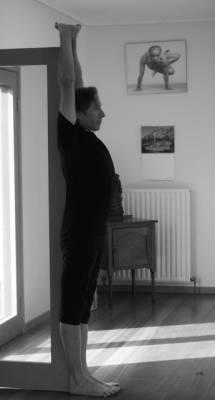 It sounds simple, but as soon as I give an instruction, such as raise your arms to shoulder height, it’s easy to lose awareness of the base . For instance in Urdhva Hastasana (upward hands pose) we need to learn to link the movement of raising our arms to the action of grounding through our feet, and then to fully extend the body from our feet to our hands. This not only brings lightness to the pose, engendering effortless effort but also helps to keep our mind fully present and helps to align the body correctly.
It sounds simple, but as soon as I give an instruction, such as raise your arms to shoulder height, it’s easy to lose awareness of the base . For instance in Urdhva Hastasana (upward hands pose) we need to learn to link the movement of raising our arms to the action of grounding through our feet, and then to fully extend the body from our feet to our hands. This not only brings lightness to the pose, engendering effortless effort but also helps to keep our mind fully present and helps to align the body correctly.
But why do we need to do this?
There is a logic to it. It is really the only way we can work; we are connected with gravity to the ground and without it, we cannot work in the same way. The base of the pose is our foundation, like the foundation of a house. If you build a house on poor foundations, no matter how beautiful its walls and windows are, it will not be stable or safe.
Our base influences our alignment in the pose –which is so important to keeping the effort of holding a pose to the minimum. We call this “effortless effort”–working only as hard as we must, and no more. Effortless effort also implies that while the body works on a muscular level the mind always remains calm and focused and the breath soft.
The difference in alignment is quite profound. When we work our legs properly, for example in Tadasana, our chest lifts up and opens, and our arms fall naturally by our sides, and in Urdhva Hastasana our arms extend over our head almost effortlessly
The discipline of working from the base
Training our minds to extend our bodies from the base of the pose is a discipline. It is like returning our focus to the breath in Pranayama (breathing poses), a discipline that needs constant practice
This discipline is, in itself, quite grounding. When our minds flit about from idea to idea, from moment to moment, we don’t feel grounded.
It also provides a structure with which we can work through each stage of the alignment of the pose. Later, when we have practiced a pose more regularly, what we learn each time we practice is remembered at a more cellular level and the mental effort of “holding”the asana eases. For instance in Adho Mukha Svanasana (downward facingdogpose) we no longer have to measure the distance and no longer have remind our selves to fully engage from the feet and the hands or lift the knee caps
It also works for us on an energetic level –we get more “lift”when we work from the base because everything is aligned and ends up in the right place. For example, in Tadasana, if your base is weak, your arms will feel heavy when you try to lift them over your head.
How do we know if we are not connected with the base
Working from the base is a gradual thing; as you get more and more connected, you know when it is working.
At first, we try to get to into poses in our head rather than listen to our body.
We need to find a little humility here, to take the time to learn each step of each pose, not to let our ego push us to be in a rush to get to the final or next pose. So we don’t jump in head first. If we find one pose is too complex for us, we come back to a pose that is simpler.
We need to get the basic asanas –such as Tadasana and Dandasana –aligned correctly before we take the next step. It is not possible to do a handstand or headstand correctly if you don’t understandTadasana.
If the base is not firm, we will shake, feel unstable, weak or heavy.
The base is our foundation, both literally and figuratively. As we practice yoga on a daily basis our knowledge or understanding is also built from a firm base.
According to Patañjali, (sutra II.46) asana is, sthira sukham asanam, "perfect firmness of body, steadiness of intelligence and benevolence of spirit".
Working from the base in Tadasana (mountain pose)
1) Stand with your feet together, big toes and ankles touching. Feet pointing straight ahead
2) Learn to spread through the balls of the feet and press evenly through the inner and outer edges of your feet
3) Distribute the weight equally through both feet and lift through the arches of your feet.
4) Lift up through your knee caps and make sure they point straight forward
5) Lift strongly through the inner thighs
6) Press the thigh bones back and outer upper thighs in.
7) Keep pelvis in a neutral position. That is not tilting forwards or backwards. When the pelvis is close to a neutral position, the pubic symphysis and upper rim of the pelvis (the anterior superior iliac spine, or ASIS) will be in the same vertical plane.
8) Keep your pelvis level and see that the left and right face straight forwards and align with each other
9) Lift and stretch up through the abdomen
10) Lift and broaden rib cage to open chest
11) Broaden collars bones and extend through arms to the finger tips, taking care not to tense or lift shoulders.
12) Look straight ahead without tilting head back. Lift up through base of skull while keep your gaze level and eyes soft. Breath normally
13) Learn to connect and observe all actions in relation to the base (the feet in this case)
When we are able to spread our awareness throughout the whole asana from the feet to the crown of the head with perfect firmness of body, steadiness of the intellect and benevolence of spirit this is mediation in action, the very essence Iyengar Yoga.
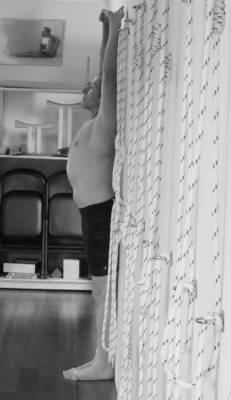
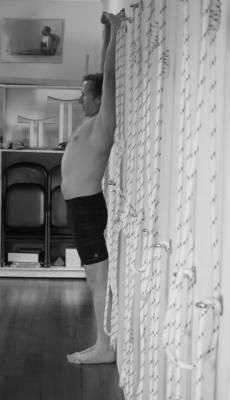
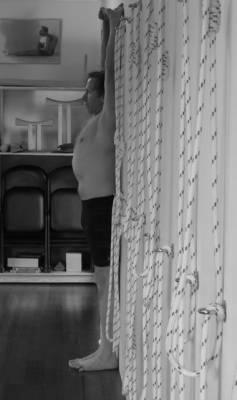
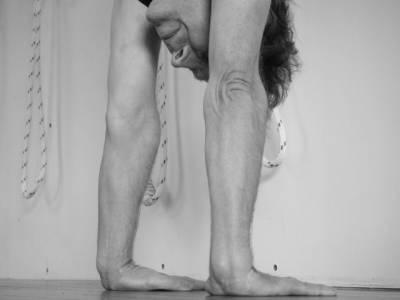
Join over 2,000 of your peers and get fortnightly articles delivered to your in box.